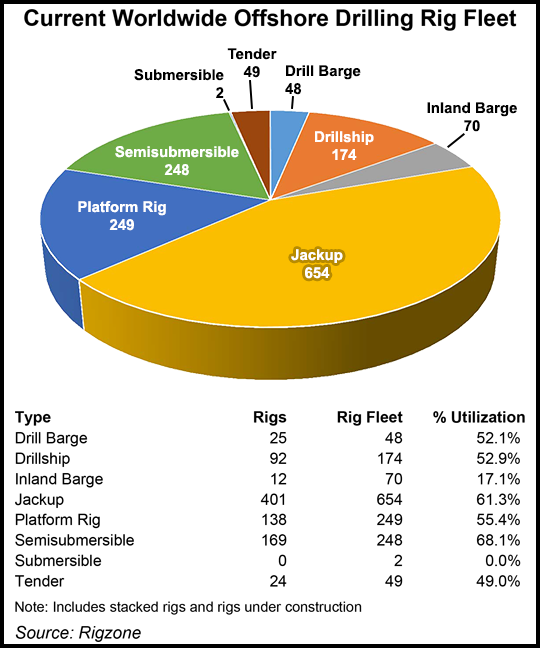NGI Archives | NGI All News Access | NGI The Weekly Gas Market Report
Technology Winners: Next Big Thing(s) Coming to Offshore Theaters Soon
Sparks of ingenuity are firing up ever-better ways to find and produce oil and natural gas from the deepest and most remote offshore reservoirs in the world, but innovators have barely touched the subsea surface, experts said at the four-day Offshore Technology Conference (OTC) in Houston.

The annual summit, the largest of its kind in the world, drew a record breaking crowd of more than 108,000 people from 40-plus countries and exhibits for 2,500 companies. From exhibits that towered above spectators to the software designs, the technological creations boggled the mind.
Inventors never want to give the final answer to the “what if?” question. It’s been the force that opened up shales and tight sandstones in the onshore, and it’s proving as reliable for offshore explorers.
For engineers at BP plc, one idea that drew accolades from the OTC evolved from a successful onshore model. The oil major was one of the technology champions at the show, unveiling a low-salinity enhanced oil recovery (EOR) technology that it has transferred successfully for offshore use. The premise is based on waterflooding, used to flush out stubborn oil.
The technology worked well in the onshore, but engineers tested and then adapted the designs for the offshore. BP boasts that the waterflooding has increased EORs by as much as 15% at a platform offshore Scotland.
It’s still in early development, but BP is way ahead of the game when it comes to defining ways to increase output, said the OTC’s award committee.
Typical offshore platforms already have a desalinization system to supply freshwater for the crew. To add another desalinization plant took some thinking. It had to be more compact — the equipment weighs tons. As important, it needed to be able to operate in an offshore environment — no sparks allowed.
The end result was a platform able to run two desalinization plants. The platform itself is a bit larger — but it’s more automated. That means fewer people. The design has become the default for BP’s waterflood projects and may be able to increase EORs by about 500 million barrels.
Houston’s Baker Hughes Inc. and Norway’s Aker Solutions offered another method to enable better technology by partnering in a Subsea Production Alliance. It’s basically, you show me yours and I’ll show you mine — to create enhanced recovery technology for the deepwater. Baker offers a variety of offshore field services, including post-drilling processes and artificial lift.
Aker manufactures subsea equipment to manage pressure pumping and transport oil to floating production platforms. By marrying some of their different technologies the partners now are puzzling together ever-stronger pumps and better delivery subsea systems. The technology still is a bit hush-hush, but the objective is to enable operators to move their oil recoveries higher and keep the costs at bay.
A similar venture is underway between Schlumberger Ltd. and Cameron International, which are offering subsea pumps that also enhance recovery. The joint company, formed last summer, not only is working on enhancements for wells, but ways to bring out more oil and gas from mature basins.
All of the oilfield companies have onshore and offshore technology that often melds. One of Halliburton Co.’s offerings is Cypher, a software-driven reservoir modeling process that was unveiled to the public last year. The engineering system originally was designed to help Devon Energy Corp. increase output from the Barnett Shale.
Cypher basically maps a reservoir. It can take minutes, compared to weeks. Repeating the mapping process in the same area also allows an operator to examine the permeability and porosity of a rock, providing treasure maps of deposits that help zero in on where to point the drill.
GE Oil & Gas has a big line of technology and service developments that it was showing off. One that drew OTC praise was Zenith, a ground fault immune (GFI) monitoring system that helps to prevent data from being lost as it’s sent from an electrical subsea pump to the surface. A short-circuit on a cable quickly can cause a lot of problems — and it can be as simple as a temperature change or a damaged cable.
The Zenith GFI monitor basically moves a signal through a damaged area by transmitting at a higher frequency than a regular gauge.
All of the new technology on display still needs people to operate a lot of it. And people are in short supply, said Douglas-Westwood Chairman John Westwood. The average U.S. oil and gas employee, he noted in a speech at the OTC, is about 50 years old.
Finding and training the next generation offers the “best hope” to develop more efficiencies and even better technologies, which he said is required as oil and gas demands expand. The low-hanging fruit, said the consultant, slowly will disappear.
“Fundamentally, we have a situation where there are major opportunities for lower cost solutions to our industry issues,” such as developing challenging reservoirs, said Westwood. “I think perhaps a lot of these new ideas will come from a new generation.”
It’s not only a lack of employees, he said. The energy industry is challenged by rising costs and a failure to manage projects adequately. He also criticized the industry’s lack of standardization, noting that unique designs are often the norm, resulting in much higher costs.
Capital spending at some point should have to come down, said Westwood. Industry capital spending climbed 25% from 2007 to 2008, but as the global markets fell, spending declined in 2009. Since then, it’s continued to escalate. Douglas-Westwood analysts don’t think “there’s going to be a total collapse” in spending, but it’s going to slowdown at some point, likely soon.
© 2024 Natural Gas Intelligence. All rights reserved.
ISSN © 1532-1231 | ISSN © 2577-9877 | ISSN © 1532-1266 |
